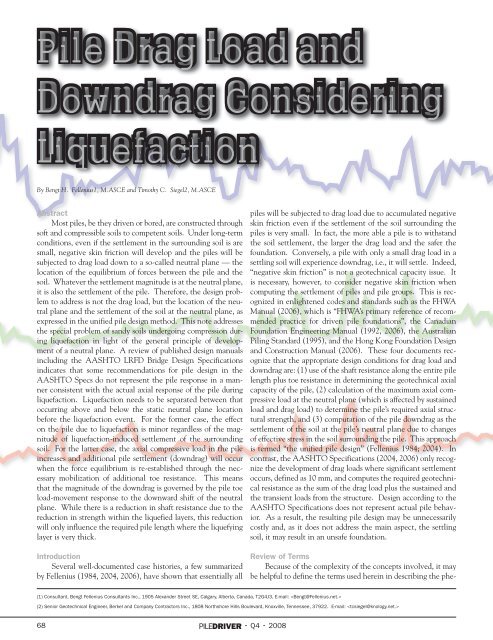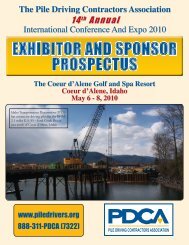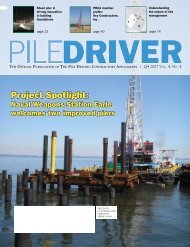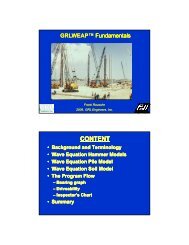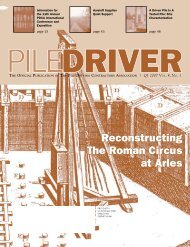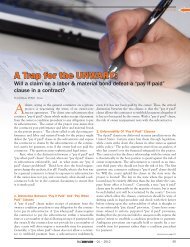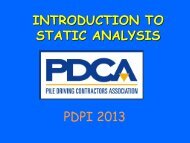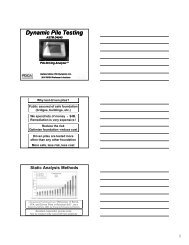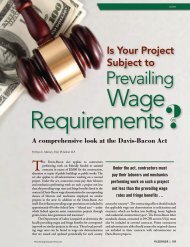Downloads - Pile Driving Contractors Association
Downloads - Pile Driving Contractors Association
Downloads - Pile Driving Contractors Association
Create successful ePaper yourself
Turn your PDF publications into a flip-book with our unique Google optimized e-Paper software.
<strong>Pile</strong> Drag Load and<br />
Downdrag Considering<br />
Liquefaction<br />
By Bengt H. Fellenius1, M.ASCE and Timothy C. Siegel2, M.ASCE<br />
Abstract<br />
Most piles, be they driven or bored, are constructed through<br />
soft and compressible soils to competent soils. Under long-term<br />
conditions, even if the settlement in the surrounding soil is are<br />
small, negative skin friction will develop and the piles will be<br />
subjected to drag load down to a so-called neutral plane — the<br />
location of the equilibrium of forces between the pile and the<br />
soil. Whatever the settlement magnitude is at the neutral plane,<br />
it is also the settlement of the pile. Therefore, the design problem<br />
to address is not the drag load, but the location of the neutral<br />
plane and the settlement of the soil at the neutral plane, as<br />
expressed in the unified pile design method. This note addresses<br />
the special problem of sandy soils undergoing compression during<br />
liquefaction in light of the general principle of development<br />
of a neutral plane. A review of published design manuals<br />
including the AASHTO LRFD Bridge Design Specifications<br />
indicates that some recommendations for pile design in the<br />
AASHTO Specs do not represent the pile response in a manner<br />
consistent with the actual axial response of the pile during<br />
liquefaction. Liquefaction needs to be separated between that<br />
occurring above and below the static neutral plane location<br />
before the liquefaction event. For the former case, the effect<br />
on the pile due to liquefaction is minor regardless of the magnitude<br />
of liquefaction-induced settlement of the surrounding<br />
soil. For the latter case, the axial compressive load in the pile<br />
increases and additional pile settlement (downdrag) will occur<br />
when the force equilibrium is re-established through the necessary<br />
mobilization of additional toe resistance. This means<br />
that the magnitude of the downdrag is governed by the pile toe<br />
load-movement response to the downward shift of the neutral<br />
plane. While there is a reduction in shaft resistance due to the<br />
reduction in strength within the liquefied layers, this reduction<br />
will only influence the required pile length where the liquefying<br />
layer is very thick.<br />
Introduction<br />
Several well-documented case histories, a few summarized<br />
by Fellenius (1984, 2004, 2006), have shown that essentially all<br />
piles will be subjected to drag load due to accumulated negative<br />
skin friction even if the settlement of the soil surrounding the<br />
piles is very small. In fact, the more able a pile is to withstand<br />
the soil settlement, the larger the drag load and the safer the<br />
foundation. Conversely, a pile with only a small drag load in a<br />
settling soil will experience downdrag, i.e., it will settle. Indeed,<br />
“negative skin friction” is not a geotechnical capacity issue. It<br />
is necessary, however, to consider negative skin friction when<br />
computing the settlement of piles and pile groups. This is recognized<br />
in enlightened codes and standards such as the FHWA<br />
Manual (2006), which is “FHWA’s primary reference of recommended<br />
practice for driven pile foundations”, the Canadian<br />
Foundation Engineering Manual (1992, 2006), the Australian<br />
Piling Standard (1995), and the Hong Kong Foundation Design<br />
and Construction Manual (2006). These four documents recognize<br />
that the appropriate design conditions for drag load and<br />
downdrag are: (1) use of the shaft resistance along the entire pile<br />
length plus toe resistance in determining the geotechnical axial<br />
capacity of the pile, (2) calculation of the maximum axial compressive<br />
load at the neutral plane (which is affected by sustained<br />
load and drag load) to determine the pile’s required axial structural<br />
strength, and (3) computation of the pile downdrag as the<br />
settlement of the soil at the pile’s neutral plane due to changes<br />
of effective stress in the soil surrounding the pile. This approach<br />
is termed “the unified pile design” (Fellenius 1984; 2004). In<br />
contrast, the AASHTO Specifications (2004, 2006) only recognize<br />
the development of drag loads where significant settlement<br />
occurs, defined as 10 mm, and computes the required geotechnical<br />
resistance as the sum of the drag load plus the sustained and<br />
the transient loads from the structure. Design according to the<br />
AASHTO Specifications does not represent actual pile behavior.<br />
As a result, the resulting pile design may be unnecessarily<br />
costly and, as it does not address the main aspect, the settling<br />
soil, it may result in an unsafe foundation.<br />
Review of Terms<br />
Because of the complexity of the concepts involved, it may<br />
be helpful to define the terms used herein in describing the phe-<br />
(1) Consultant, Bengt Fellenius Consultants Inc., 1905 Alexander Street SE, Calgary, Alberta, Canada, T2G4J3, E-mail: <br />
(2) Senior Geotechnical Engineer, Berkel and Company <strong>Contractors</strong> Inc., 1808 Northshore Hills Boulevard, Knoxville, Tennessee, 37922. E-mail: <br />
68 • Q4 • 2008


